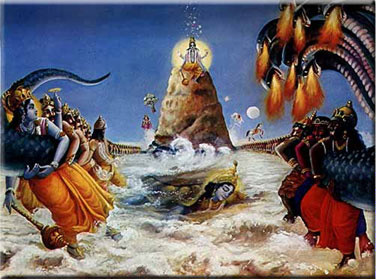Kumbh Mela: A Festival of Immortality
Maha Kumbh Mela
What do saints and sadhus, sannyasis (renunciants) and businessmen, housewives and farmers, teachers and students, scientists and the superstitious, poets and politicians, mystics and beggars all have in common? The quest for immortality! What else could bring together such a multitude of individuals to one congested river bank for forty days?
Besides being the largest gathering of human beings anywhere in the world, the Kumbh Mela can evoke the deepest spiritual sentiments of an individual.
The Kumbh mela is by far the largest religious phenomenon in which the collective destiny and spiritual urges of the human race find expression. Kumbh is a Sanskrit word meaning “pot” ,“pitcher” or “jar” and mela means “festival.” According to Indian mythology, the Kumbh mela derives its name from the pot of the immortalizing nectar.
Held at the confluence (sangam) of the three most holy rivers in India: the Ganga, the Yamuna, and the subterranean Sarasvati, the Kumbh Mela lures the faithful for a dip in the holy waters that relieves lifetimes of karmic reactions. There is a scriptural understanding that bathing on the astrologically propitious “peak” holy days extinguishes uncountable sins, relieving the pilgrim of his or her entanglement in the complex cycle of birth, disease, old age, and death. One can thus transcend the mortal world of perpetual reincarnation, of duality and suffering, and hasten one’s return back home, back to Godhead.
A veritable sea of swaying bodies and heads moves inexorably to the confluence. Accompanied by the cacophonous clamor of bells, cymbals, horns, whooping, the shouting of invocations, and the constant blaring of devotional songs over a ubiquitous P.A. system, armies of ascetics and cityfolk alike cry out, “Bolo Ganga-mayiya ki jaya! shri Yamuna mayiya ki jaya! [All glories to the Ganges and Yamuna!]” creating a thunderous symphony of reverential incantation.
During the sacred bathing period, caste and racial divisions and the demarcations of various cults and sects dissolve, as one person assists the other in cleansing the body and the soul.
The Festival serves as a melting pot for more than eight thousand groups and religious institutions. Here they exchange philosophical ideas and share spiritual realizations. Some say the mela is a symbol of Hindu unity, offering a means of transmitting the spiritual and ascetic values of ancient Vedic culture to the masses of devotees.
Cornered by Buddhism, Jainism, and Islam in the eighth century, Hindu civilization (more appropriately called Vedic civilization) was thought to be in danger of extinction. Therefore Sankaracarya, India’s ninth-century religious reformer (and, according to the Puranas, an incarnation of Siva), instituted at the Kumbh mela regular summit meetings of spiritual leaders as a buttress for the survival of Vedic theism. Some say that it was Sankaracarya who started the festival, but scriptural references about the Mela predating Sankara prove such a theory inaccurate.
The Mela has become a forum by which the saintly and self-realized impart by example mystical and moral codes to the devoted. Alongside enlightened spiritual masters, however, fakes and frauds abound.
The Kumbh mela has had a magnetism for saints and scholars for thousands of years. As early as 302 B.C. the great Greek historian Megasthenes documented his seventy-five-day stay at Prayaga (Allahabad), during mela that boasted an attendance of two and a half million. Later, in the seventh century A.D., the pious emperor Harsha invited the eminent Chinese mendicant Hieun Tsang to join in the festivities. In his journals Tsang praised the emperor’s exemplary spiritual leadership:
“The festival concluded with Harsha’s lavishly distributing all of his accumulated wealth to the needy, down to his robes, and returning to his palace in clothes borrowed from his sister.”


